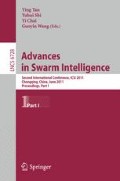Abstract
Swarm intelligent, cooperative object recognition forms part of cooperative construction research. A simulation model was designed and utilised to assess the suitability of a swarm of agents to identify and collect different objects, termed the Simplified Hexagonal Model. An agent in this system cannot assess different object types alone. Key to the efficiency of the system is avoiding stagnation whilst maintaining robustness. This paper examines the energy efficiency of the system when the probability of an agent moving away from an object it is trying to identify is varied. The probability of an agent moving away from an unidentified object per time-step was varied from 1:12 to 1:400. Both low and high probabilities increased the energy required to complete the task. This was more pronounced when using fewer agents. The reduced chance that the required number of agents were surrounding the same objects at the same time caused the increase.
Access this chapter
Tax calculation will be finalised at checkout
Purchases are for personal use only
Preview
Unable to display preview. Download preview PDF.
References
Brooks, R.A., Maes, P., Mataric, M.J., et al.: Lunar Base Construction Robots. In: IEEE International Workshop on Intelligent Robots and Systems, vol. 1, pp. 389–392 (1990)
Wawerla, J., Sukhatme, G.S., Mataric, M.J.: Collective Construction with Multiple Robots. In: Proceedings of 2002 IEEE/RSJ International Conference on Intelligent Robots and Systems, vol. 3, pp. 2696–2701 (2002)
Werfel, J., Bar-Yam, Y., Nagpal, R.: Building Patterned Structures with Robot Swarms. In: Su, D., Zhang, Q., Zhu, S. (eds.) 19th International Joint Conference on Artificial Intelligence, IJCAI 2005, pp. 1495–1502 (2005)
Werfel, J.: Robot Search in 3D Swarm Construction. In: 1st. International Conference on Self-Adaptive and Self-Organizing Systems, pp. 363–366 (2007)
Werfel, J., Nagpal, R.: Three-Dimensional Construction with Mobile Robots and Modular Blocks. Int. J. Robot. Res. 27(3-4), 463–479 (2008)
Franks, N.R., Deneeubourg, J.L.: Self-Organizing Nest Construction in Ants: Individual Worker Behaviour and the Nest’s Dynamics. Anim. Behav. 54, 779–796 (1997)
Theraulaz, G., Bonabeau, E.: Modelling the Collective Building of Complex Architectures in Social Insects with Lattice Swarms. J. Theor. Biol. 177, 381–400 (1995)
Mason, Z.: Programming with Stigmergy: Using Swarms for Construction. In: Standish, R.K., Bedau, M.A., Abbas, H.A. (eds.) Artifical Life VIII, pp. 371–374. MIT Press, Cambridge (2002)
Kube, C.R., Zhang, H.: Collective Robotics: From Social Insects to Robots. Adapt. Behav. 2(2), 189–219 (1993)
Kube, C.R., Bonabeau, E.: Cooperative Transport by Ants and Robots. Robot. Auton. Sys. 30, 85–101 (2000)
Zhang, D., Xie, G., Yu, J., et al.: Adaptive Task Assignment for Multiple Mobile Robots via Swarm Intelligence Approach. Robot. and Auton. Sys. 55, 572–588 (2007)
Payton, D., Estkowski, R., Howard, M.: Compound Behaviours in Pheromone Robotics. Robot. Auton. Sys. 44, 229–240 (2003)
Oswald, N., Levi, P.: Cooperative Vision in Multi-Agent Architecture. In: Del Bimbo, A. (ed.) ICIAP 1997. LNCS, vol. 1310, pp. 709–716. Springer, Heidelberg (1997)
Processing, http://processing.org/
King, D., Breedon, P.: Towards Cooperative Robotic Swarm Recognition: Object Classification and Validation. In: 3rd International Conference on Advanced Design Manufacture. Key Eng. Mat, vol. 450, pp. 320–324. Trans Tech Publications (2010)
Author information
Authors and Affiliations
Editor information
Editors and Affiliations
Rights and permissions
Copyright information
© 2011 Springer-Verlag Berlin Heidelberg
About this paper
Cite this paper
King, D., Breedon, P. (2011). Robustness and Stagnation of a Swarm in a Cooperative Object Recognition Task. In: Tan, Y., Shi, Y., Chai, Y., Wang, G. (eds) Advances in Swarm Intelligence. ICSI 2011. Lecture Notes in Computer Science, vol 6728. Springer, Berlin, Heidelberg. https://doi.org/10.1007/978-3-642-21515-5_3
Download citation
DOI: https://doi.org/10.1007/978-3-642-21515-5_3
Publisher Name: Springer, Berlin, Heidelberg
Print ISBN: 978-3-642-21514-8
Online ISBN: 978-3-642-21515-5
eBook Packages: Computer ScienceComputer Science (R0)

